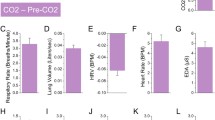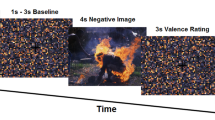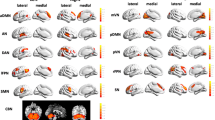Abstract
There is evidence that besides limbic brain structures, prefrontal and insular cortical activations and deactivations are involved in the pathophysiology of panic disorder. This study investigated activation response patterns to stimulation with individually selected panic-specific pictures in patients with panic disorder with agoraphobia (PDA) and healthy control subjects using functional magnetic resonance imaging (fMRI). Structures of interest were the prefrontal, cingulate, and insular cortex, and the amygdalo-hippocampal complex. Nineteen PDA subjects (10 females, 9 males) and 21 healthy matched controls were investigated using a Siemens 3-Tesla scanner. First, PDA subjects gave Self-Assessment Manikin (SAM) ratings on 120 pictures showing characteristic panic/agoraphobia situations, of which 20 pictures with the individually highest SAM ratings were selected. Twenty matched pictures showing aversive but not panic-specific stimuli and 80 neutral pictures from the International Affective Picture System were chosen for each subject as controls. Each picture was shown twice in each of four subsequent blocks. Anxiety and depression ratings were recorded before and after the experiment. Group comparisons revealed a significantly greater activation in PDA patients than control subjects in the insular cortices, left inferior frontal gyrus, dorsomedial prefrontal cortex, the left hippocampal formation, and left caudatum, when PA and N responses were compared. Comparisons for stimulation with unspecific aversive pictures showed activation of similar brain regions in both groups. Results indicate region-specific activations to panic-specific picture stimulation in PDA patients. They also imply dysfunctionality in the processing of interoceptive cues in PDA and the regulation of negative emotionality. Therefore, differences in the functional networks between PDA patients and control subjects should be further investigated.

Similar content being viewed by others
References
Wittchen HU, Jacobi F, Rehm J et al (2011) The size and burden of mental disorders and other disorders of the brain in Europe 2010. Eur Neuropsychopharmacol 21(9):655–679
Kessler RC, Chiu WT, Demler O, Merikangas KR, Walters EE (2005) Prevalence, severity, and comorbidity of 12-month DSM-IV disorders in the National Comorbidity Survey Replication. Arch Gen Psychiatry 62(6):617–627
Cameron OG (2001) Interoception: the inside story—a model for psychosomatic processes. Psychosom Med 63:697–710
Damasio AR (1996) The somatic marker hypothesis and the possible functions of the prefrontal cortex. Philos Trans R Soc Lond B Biol Sci 351:1413–1420
Damasio AR (1999) The feeling of what happens: body and emotion in the making of consciousness. Harcourt Barce, New York
Dolan RJ (2002) Emotion, cognition, and behaviour. Science 298:1191–1194
Critchley HD, Wiens S, Rotshtein P, Öhman A, Dolan RJ (2004) Neural systems supporting interoceptive awareness. Nat Neurosci 7(2):189–195
Gorman JM, Kent JM, Sullivan GM, Coplan JD (2000) Neuroanatomical hypothesis of panic disorder, revised. Am J Psychiatry 157:493–505
Sakai Y, Kumano H, Nishikawa M et al (2005) Cerebral glucose metabolism associated with a fear network in panic disorder. NeuroReport 16(9):927–931
Nagai M, Kishi K, Kato S (2007) Insular cortex and neuropsychiatric disorders: a review of recent literature. Eur Psychiatry 22(6):387–394
Cameron OG, Huang GC, Nichols T et al (2007) Reduced γ-aminobutyric-acidA—benzodiazepine binding sites in insular cortex of individuals with panic disorder. Arch Gen Psychiatry 64(7):793–800
Malizia AL, Cunningham VJ, Bell CJ, Liddle PF, Jones T, Nutt DJ (1998) Decreased brain GABA(A)-benzodiazepine receptor binding in panic disorder: preliminary results from a quantitative PET study. Arch Gen Psychiatry 55(8):715–720
Engel K, Bandelow B, Gruber O, Wedekind D (2009) Neuroimaging in anxiety disorders. J Neural Transm 116(6):703–716
Dager SR, Friedman SD, Heide A et al (1999) Two-dimensional proton echo-planar spectroscopic imaging of brain metabolic changes during lactate-induced panic. Arch Gen Psychiatry 56:70–77
Dager SR, Marro KI, Richards TL, Metzger GD (1994) Preliminary application of magnetic resonance spectroscopy to investigate lactate-induced panic. Am J Psychiatry 151:57–63
Dager SR, Richards T, Strauss W, Artru A (1997) Single-voxel 1H-MRS investigation of brain metabolic changes during lactate-induced panic. Psychiatry Res 76:89–99
Gerakani A, Buchsbaum MS, Newmark RE et al (2007) The effect of doxapram on brain imaging with panic disorder. Eur Neuropsychopharmacol 17(10):672–686
Simmons A, Matthews SC, Stein MB, Paulus MP (2004) Anticipation of emotionally aversive visual stimuli activates right insula. NeuroReport 15:2261–2265
Yaguez KL, Coen S, Gregory LJ et al (2005) Brain response to visceral aversive conditioning: a functional magnetic resonance imaging study. Gastroenterology 128:1819–1829
Maddock RJ, Buonocore MH, Kile SJ, Garrett AS (2003) Brain regions showing increased activation in thread-related words in panic disorder. NeuroReport 14:325–328
Van der Heuvel OA, Veltman DJ, Groenewegen HJ et al (2005) Disorder-specific neuroanatomical correlates of attentional bias in obsessive-compulsive disorder, panic disorder, and hypochondriasis. Arch Gen Psychiatry 62:922–933
Pillay SS, Gruber SA, Rogowska J, Simpson N, Yurgelun-Todd DA (2006) fMRI of fearful facial affect recognition in panic disorder: the cingulated gyrus-amygdala connection. J Affect Disord 94:173–181
Bystritsky A, Pontillo D, Powers M, Sabb FW, Craske MG, Bookheimer SY (2001) Functional MRI changes during panic anticipation and imagery exposure. NeuroReport 12:3953–3957
Demenescu LR, Kortekaas R, Cremers HR et al (2013) Amygdala activation and its functional connectivity during perception of emotional faces in social phobia and panic disorder. J Psychiatr Res 47(8):1014–1031
Wittmann A, Schlangenhauf F, Guhn A et al (2014) Anticipating agoraphobic situations: the neural correlates of panic disorder with agoraphobia. Psychol Med 44(11):2385–2396
Brühl AB, Rufer M, Delsignore A, Kaffenberger T, Jäncke L, Herwig U (2011) Neural correlates of altered general emotion processing in social anxiety disorder. Brain Res 1378:72–83
American Psychiatric Association (APA) (1994) Diagnostic and statistical manual of mental disorders, 4th edn. American Psychiatric Press, Washington DC
Guy W (1976) Clinical global impression. In: Guy W (ed) ECDEU assessment manual for psychopharmacology, revised. NIMH, Rockville, pp 217–222
Bandelow B (1995) Assessing the efficacy of treatments for panic disorder and agoraphobia. II. The Panic and Agoraphobia Scale. Int Clin Psychopharmacol 10(2):73–81
Bandelow B (1999) Panic and Agoraphobia Scale (PAS). Hogrefe & Huber Publishers, Goettingen/Bern/Toronto/Seattle
Bradley MM, Lang PJ (1994) Measuring emotion: the self-assessment manikin and the semantic differential. J Behav Therap Exp Psychiatry 25(1):49–59
Engel KR, Bandelow B, Neumann C, Obst K, Wedekind D (2012) Disorder-specific emotional imagery for differential and quantitative assessment of agoraphobia. Curr Pharm Des 18(35):5638–5644
Lang PJ, Bradley MM, Cuthbert BN (1997) International Affective Picture System (IAPS): technical manual and affective ratings. NIMH Center for the Study of Emotion and Attention, University of Florida, Gainesville
Brett M, Anton JL, Valabregue R, Poline JB (2002) Region of interest analysis using an SPM toolbox [abstract]. Presented at the 8th International Conference on Functional Mapping of the Human Brain, June 2–6, 2002, Sendai, Japan. Available on CD-ROM in NeuroImage, vol 16(2)
Etkin A, Egner T, Peraza DM, Kandel ER, Hirsch J (2006) Resolving emotional conflict: a role for the rostral anterior cingulate cortex in modulating activity in the amygdala. Neuron 51(6):871–882
Haas BW, Omura K, Constable RT, Canli T (2006) Interference produced by emotional conflict associated with anterior cingulate activation. Cogn Affect Behav Neurosci 6(2):152–156
Gorka SM, Nelson BD, Phan KL, Shankman SA (2014) Insula response to unpredictable aversiveness in individuals with panic disorder and comorbid depression. Biol Mood Anxiety Disord 4:9. doi:10.1186/2045-5380-4-9
Goossens L, Leibold N, Peeters R et al (2014) Brainstem responses to hypercapnia: a symptom provocation study into the pathophysiology of panic disorder. J Psychopharmacol 28(5):449–456
Ueda K, Okamoto Y, Okada G, Yamashita H, Hori T, Yamawaki S (2003) Brain activity during expectancy of emotional stimuli: an fMRI study. NeuroReport 14(1):51–55
Pfleiderer B, Berse T, Stroux D et al (2014) Internal focus of attention in anxiety-sensitive females up-regulates amygdale activity: an fMRI study. J Neural Transm 121:1417–1428
Pfleiderer B, Zinkirciran S, Michael N et al (2010) Altered auditory processing in patients with panic disorder: a pilot study. World J Biol Psychiatry 11(8):945–955
Reinecke A, Thilo K, Filipini N, Croft A, Harmer CJ (2014) Predicting rapid response to cognitive-behavioural treatment for panic disorder: the role of hippocampus, insula, and dorsolateral prefrontal cortex. Behav Res Ther 62:120–128
Author contribution
D.W., K.O., KR.E., O.G., P.D., and B.B. involved in planning of the study. D.W., KR.E., and K.U. involved in patient recruitment and acquisition of data. D.W., K.O., O.G. P.D., and B.B. analysed the data. D.W., K.O., KR.E., B.B., O.G., P.D., I.Z., and K.U. drafted the manuscript and finally approved the article.
Author information
Authors and Affiliations
Corresponding author
Ethics declarations
Conflict of interest
All authors declare no conflict of interest concerning the content of this manuscript.
Additional information
K. R. Engel and K. Obst contributed to this article to equal parts.
Rights and permissions
About this article
Cite this article
Engel, K.R., Obst, K., Bandelow, B. et al. Functional MRI activation in response to panic-specific, non-panic aversive, and neutral pictures in patients with panic disorder and healthy controls. Eur Arch Psychiatry Clin Neurosci 266, 557–566 (2016). https://doi.org/10.1007/s00406-015-0653-6
Received:
Accepted:
Published:
Issue Date:
DOI: https://doi.org/10.1007/s00406-015-0653-6




